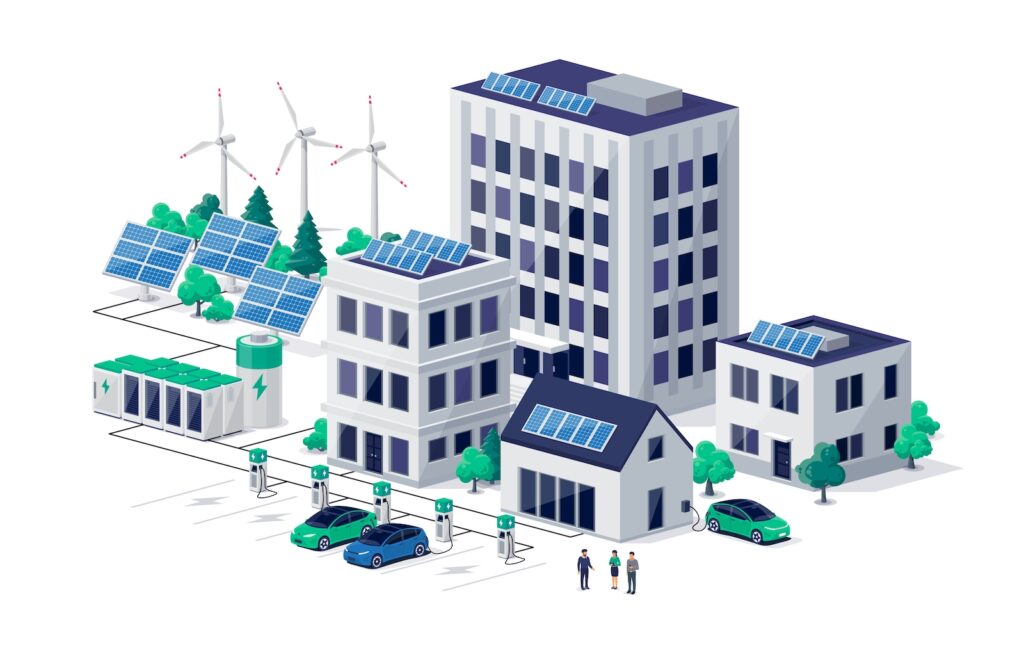The adoption of smart buildings and cities continues to grow around the world to increase energy efficiency and human-centric benefits while reducing our negative impact on the environment. However, as smart technology continues to proliferate it has become clear that our current electrical system was not designed for this modern world. From IoT devices to heating and cooling, to lighting and electric vehicle charging, our built environment now demands new forms of energy provision that centre around the electrification of everything. The future of our rapidly evolving smart environments will now depend on the slow-moving energy industry to change quickly.
“The energy transition will seem slow to a company like Google, but it will be fast for energy companies, who have to request permission from a commission to deploy infrastructure on behalf of ratepayers. There’s a process that’s very, very important to ensure reliability, affordability, and sustainability,” said Duncan Rotherham, vice president of beneficial electrification at global advisory firm ICF. “There’s probably a little bit too much ambition on velocity, from my perspective, on how quickly this whole thing will change, but it will change. Every day we take longer, it costs us time.”
In the simplest sense, electrification means we can power everything in buildings and cities by renewable energy, but it is not as simple as plugging in solar panels at one end of the grid and electric-powered devices at the other. Renewable energy is intermittent, fluctuating its supply based on the strength of the wind and solar radiation, and will therefore require energy storage systems in buildings to balance loads. The introduction of electric vehicles (EV) and their charging infrastructure now demands neighbourhood-level storage infrastructure that can support the use of intermittent renewables on a larger scale. And, our smart environments will even demand changes in the way electricity is transported.
Most modern devices use direct current (DC) electricity, including LED lights, HVAC systems, computers, microwave ovens, and much more. Today, DC consumption currently makes up approximately 32% of total energy loads but could rise to as much as 74% in buildings that use electric vehicles and HVAC equipment with DC motors, according to the US Green Buildings Council. However, our existing power grids distribute alternating current (AC) electricity to our buildings and cities, meaning the growing number of DC-powered devices must convert the AC power they get into the DC power they need, which leads to inefficiency and wasted energy.

“Most modern devices and systems require DC electricity, and this is no different for smart buildings or homes. But if high consumption devices, like LED lighting and HVAC, still have to convert AC to DC electricity, energy is still being wasted,” says Erin Kelly, Creative Director at Argentum Electronics. “As it becomes more beneficial than ever for buildings to reduce their energy consumption, it's time to reconsider whether AC electricity should remain the standard type of electricity transmitted throughout the world (or at least in buildings).”
AC electricity is the chosen standard in the world today because Nikola Tesla won the War of the Currents back in the late 19th century. Tesla's AC power distribution method was chosen as it is more compatible with transformers, allowing cheaper transmission of electricity over long distances. However, that decision was taken over 100 years ago, since then technological advancements like rectifier stations and mercury arc values now enable DC to compete with or complement AC for cost of long-distance transmission, while reducing energy waste at the device level. “We need a revolution in just basic electricity before a lot of our smart building technologies will actually be implemented” stated Brad Koerner at the Smart Building Conference in 2020.
“Put simply, an energy transition represents a profound change in the energy system, but the world has made the transition from one dominant form of energy to another several times. The replacement of fossil fuels with renewables marks the next historic shift. Yet, to ensure sustainability and global climate stability, this latest energy transformation needs to happen much faster,” reads a statement by the International Renewable Energy Agency (IRENA). “Countries around the world need a vast expansion of renewables, smarter and more flexible electricity grids, and huge increases in the numbers of vehicles and other products and processes that run on electricity.”



